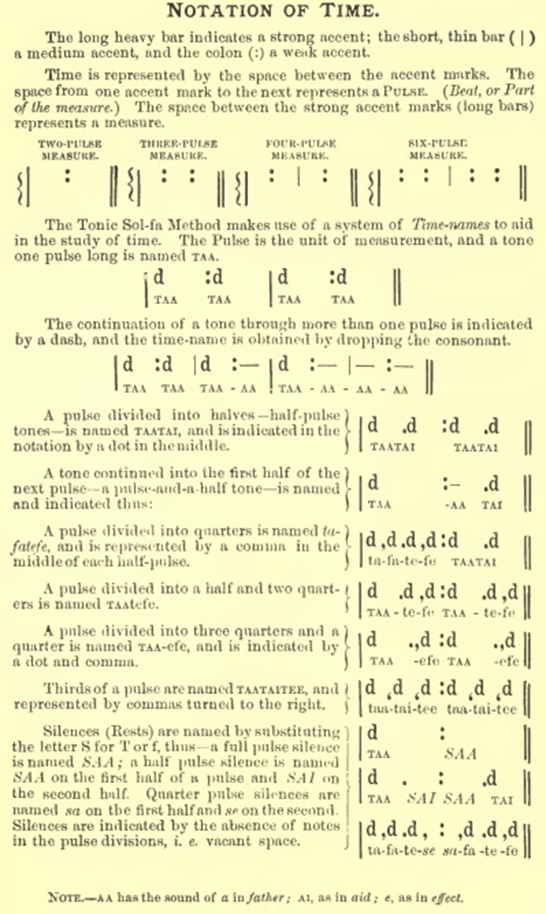


The Tonic Sol-Fa Music Reader, Revised and Improved, a Course of Instruction and Practice in the Tonic Sol-Fa Method of Teaching Singing, with a Choice Collection of Music Suitable for Day Schools and Singing Schools was first published in 1880 by Theodore Frelinghuysen Seward (1835-1902) and Benjamin Carl Unseld (1843-1923). The tonic sol-fa music system does not use musical notes on the staff. Instead, the musical tones are marked with the first letter of each syllable of the scale: "d, r, m, f, s, l, t." Unseld would practice the Tonic Sol-Fa system as a hobby.
The Tonic Sol-Fa music notation system was developed in England by Miss Sarah Ann Glover (1785–1867) and perfected by Rev. John Curwen (1816-1880), a Methodist minister. It was Miss Glover's religious mission to teach children, including the children of the poor, to read music, and to perfect singing from that music.
In 1841, Curwen was commissioned by a conference of Sunday school teachers to find a simple method to assist congregations to "sing with ease and propriety." Curwen found Miss Glover's system and perfected it to generate a teaching tool. By the end of the nineteenth century, this music method was being taught in schools to the children throughout Great Brittain. It began to decline in the 1920s.
The promoters of this music system held the argument that the use of the syllable "Si" should not be used twice—first as the seventh tone of the major scale, and second as a tone that represents the raising of "Sol" a half step. Their second argument was that "the letter ‘s' has the most unpleasant sound in the language," and it should not occur more than once. The third argument was that this change would give an additional consonant and would be useful for practicing articulation. The final argument was, in the sol-fa notation, a different initial letter was needed to represent "Sol" and "Si." With this argument, the seventh syllable was changed from "Si" to "Ti."
This new change in the syllables for the scale left its influence in modern music education. In the academic world, we now use "Ti" as the seventh syllable, and "Si" is the syllable to use when raising "Sol" a half step.
One could only think how Rodgers and Hammerstein's Sound of Music lyrics to Do Re Mi would have been written when "Si" was seventh syllable. Where they sing, "Tea, a drink with jam and bread," they could have been singing, perhaps, "Sea, a place to sail my boat."
Seward and Unseld's book brought this system to the United States. They were also participants of writing new music for what would become known as Southern Gospel Singing. This syllable change would also be used in Southern Gospel Singings as well as newly published church hymnals.


Sources:
McLemore, B. F. Tracing the Roots of Southern Gospel Singers. (Jasper, TX: B. F. (Bob) McLemore, 2005).
McNaught, W. G. "The History and Uses of the Sol-Fa Syllables" Proceedings of the Musical Association for the Investigation and Discussion of Subjects Connected with the Art and Science of Music, Volume 19, 1892-93. (London: Novello, Ewer and Co., 1893).
Seward, Theodore F, and Benjamin C. Unseld. The Tonic Sol-Fa Music Reader, Revised and Improved, a Course of Instruction and Practice in the Tonic Sol-Fa Method of Teaching Singing, with a Choice Collection of Music Suitable for Day Schools and Singing Schools. (New York: The Biglow & Main Company, 1890).
Stevens, Robin. "A System Ahead of Its Time." Music in Action, Vol. 6, No. 1, pp. 8-11, (Malvern, Vic., Australia: Australian Music Association, 2008).
Waterhouse, Celia. "An Appraisal of Sarah Glover's Norwich Sol-fa Method." The British Kodály Academy, <https://www.kodaly.org.uk/news/an-appraisal-of-sarah-glovers-norwich-sol-fa-method-by-celia-waterhouse>. (30 September 2023).